Global Expansion: Franchising Advantages, Disadvantages & Management
VerifiedAdded on 2023/04/07
|10
|2435
|396
Essay
AI Summary
This essay provides a comprehensive analysis of international franchising as a global strategy for business expansion. It details the advantages such as easy expansion, capital, exposure to new markets, staffing leverage, ease of supervision, and increased profitability. Conversely, it also examines the disadvantages including cultural differences, compliance challenges, bad reputation, and higher initial costs. The essay further explores considerations for managing across borders, focusing on cultural barriers, local competition, political problems, tax codes, compliance issues, and language barriers, providing examples of companies like Unilever and McDonald's to illustrate these points. This document is available on Desklib, a platform offering a range of study tools and solved assignments for students.

0
Global Strategy
Global Strategy
Paraphrase This Document
Need a fresh take? Get an instant paraphrase of this document with our AI Paraphraser
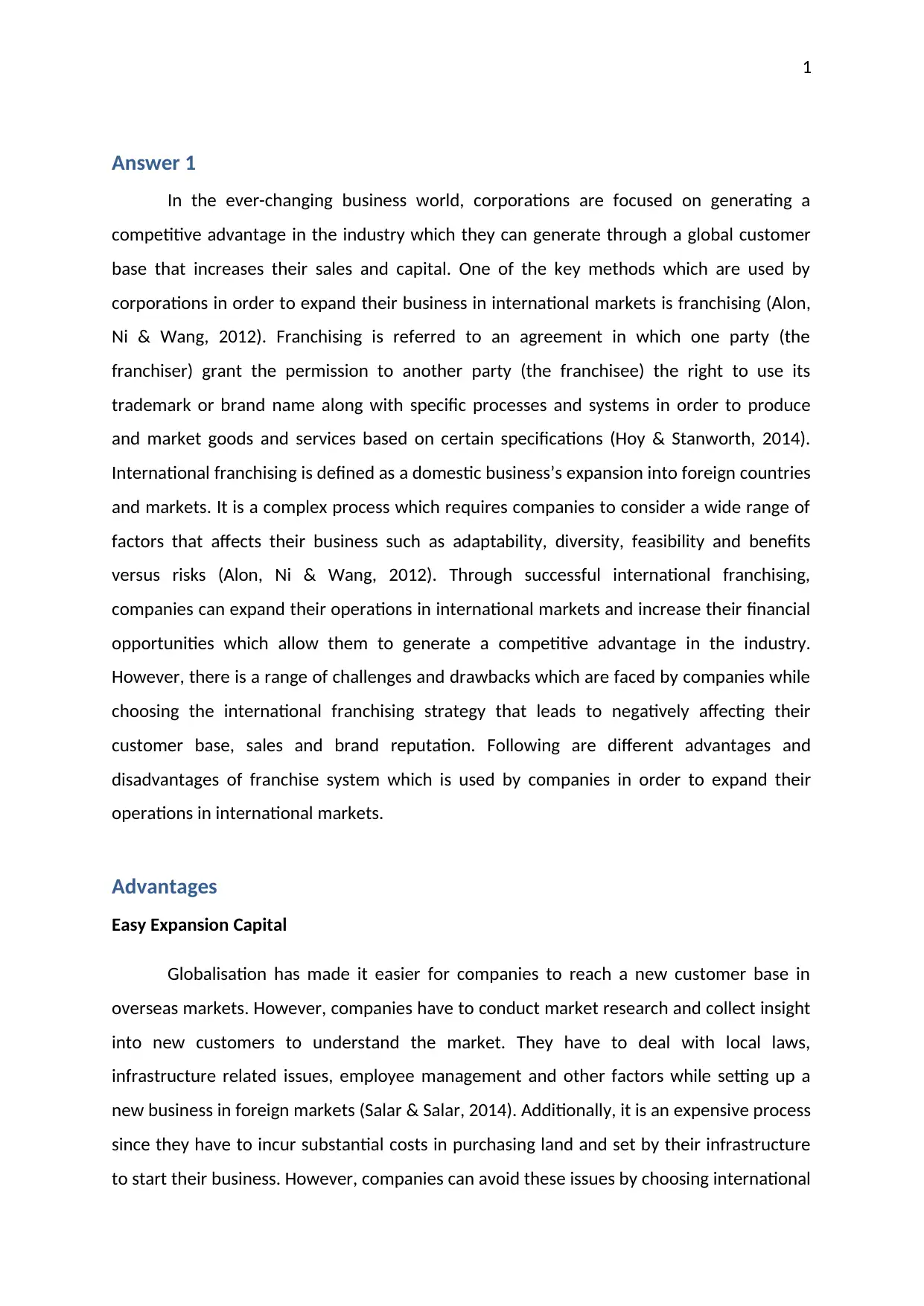
1
Answer 1
In the ever-changing business world, corporations are focused on generating a
competitive advantage in the industry which they can generate through a global customer
base that increases their sales and capital. One of the key methods which are used by
corporations in order to expand their business in international markets is franchising (Alon,
Ni & Wang, 2012). Franchising is referred to an agreement in which one party (the
franchiser) grant the permission to another party (the franchisee) the right to use its
trademark or brand name along with specific processes and systems in order to produce
and market goods and services based on certain specifications (Hoy & Stanworth, 2014).
International franchising is defined as a domestic business’s expansion into foreign countries
and markets. It is a complex process which requires companies to consider a wide range of
factors that affects their business such as adaptability, diversity, feasibility and benefits
versus risks (Alon, Ni & Wang, 2012). Through successful international franchising,
companies can expand their operations in international markets and increase their financial
opportunities which allow them to generate a competitive advantage in the industry.
However, there is a range of challenges and drawbacks which are faced by companies while
choosing the international franchising strategy that leads to negatively affecting their
customer base, sales and brand reputation. Following are different advantages and
disadvantages of franchise system which is used by companies in order to expand their
operations in international markets.
Advantages
Easy Expansion Capital
Globalisation has made it easier for companies to reach a new customer base in
overseas markets. However, companies have to conduct market research and collect insight
into new customers to understand the market. They have to deal with local laws,
infrastructure related issues, employee management and other factors while setting up a
new business in foreign markets (Salar & Salar, 2014). Additionally, it is an expensive process
since they have to incur substantial costs in purchasing land and set by their infrastructure
to start their business. However, companies can avoid these issues by choosing international
Answer 1
In the ever-changing business world, corporations are focused on generating a
competitive advantage in the industry which they can generate through a global customer
base that increases their sales and capital. One of the key methods which are used by
corporations in order to expand their business in international markets is franchising (Alon,
Ni & Wang, 2012). Franchising is referred to an agreement in which one party (the
franchiser) grant the permission to another party (the franchisee) the right to use its
trademark or brand name along with specific processes and systems in order to produce
and market goods and services based on certain specifications (Hoy & Stanworth, 2014).
International franchising is defined as a domestic business’s expansion into foreign countries
and markets. It is a complex process which requires companies to consider a wide range of
factors that affects their business such as adaptability, diversity, feasibility and benefits
versus risks (Alon, Ni & Wang, 2012). Through successful international franchising,
companies can expand their operations in international markets and increase their financial
opportunities which allow them to generate a competitive advantage in the industry.
However, there is a range of challenges and drawbacks which are faced by companies while
choosing the international franchising strategy that leads to negatively affecting their
customer base, sales and brand reputation. Following are different advantages and
disadvantages of franchise system which is used by companies in order to expand their
operations in international markets.
Advantages
Easy Expansion Capital
Globalisation has made it easier for companies to reach a new customer base in
overseas markets. However, companies have to conduct market research and collect insight
into new customers to understand the market. They have to deal with local laws,
infrastructure related issues, employee management and other factors while setting up a
new business in foreign markets (Salar & Salar, 2014). Additionally, it is an expensive process
since they have to incur substantial costs in purchasing land and set by their infrastructure
to start their business. However, companies can avoid these issues by choosing international
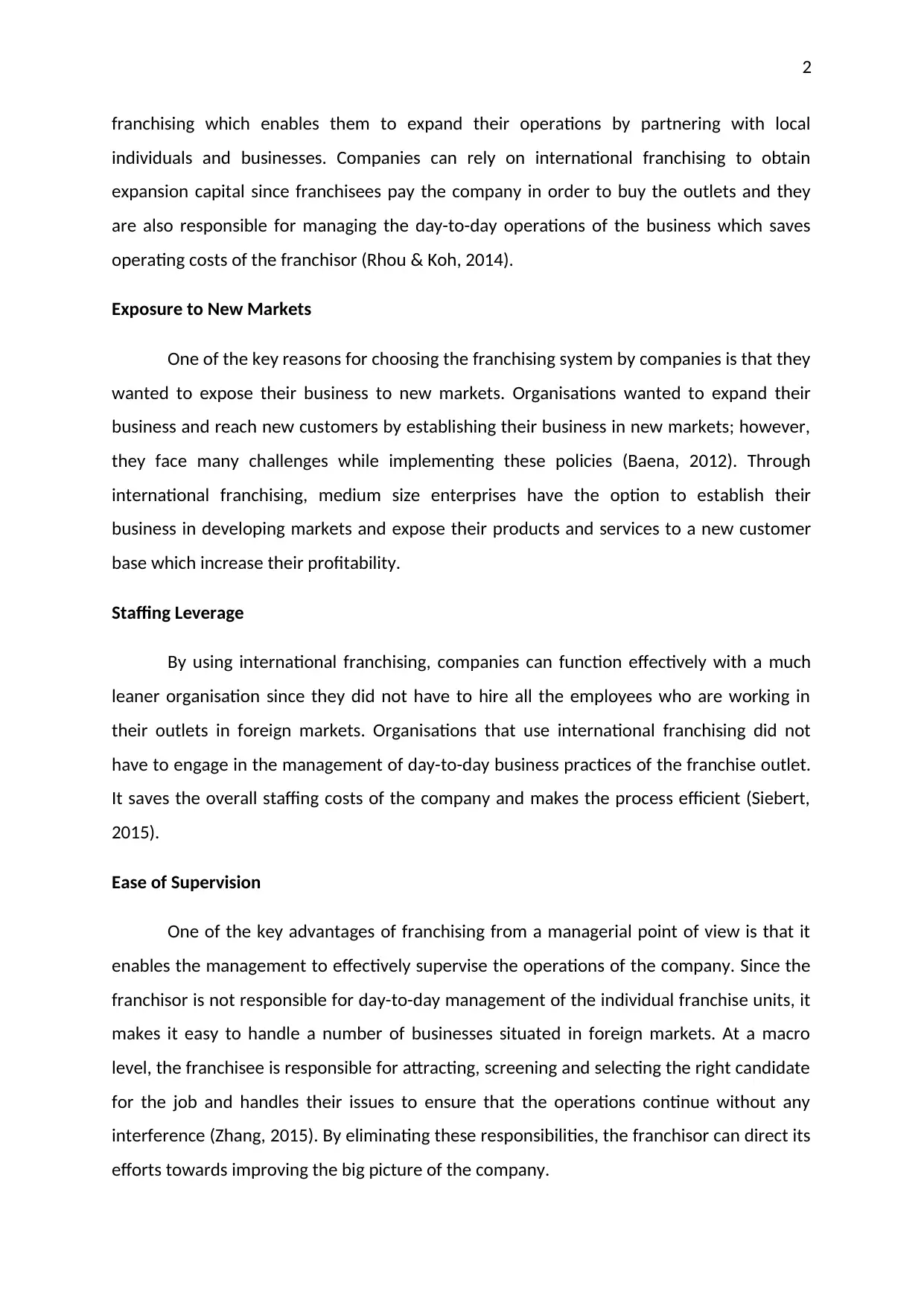
2
franchising which enables them to expand their operations by partnering with local
individuals and businesses. Companies can rely on international franchising to obtain
expansion capital since franchisees pay the company in order to buy the outlets and they
are also responsible for managing the day-to-day operations of the business which saves
operating costs of the franchisor (Rhou & Koh, 2014).
Exposure to New Markets
One of the key reasons for choosing the franchising system by companies is that they
wanted to expose their business to new markets. Organisations wanted to expand their
business and reach new customers by establishing their business in new markets; however,
they face many challenges while implementing these policies (Baena, 2012). Through
international franchising, medium size enterprises have the option to establish their
business in developing markets and expose their products and services to a new customer
base which increase their profitability.
Staffing Leverage
By using international franchising, companies can function effectively with a much
leaner organisation since they did not have to hire all the employees who are working in
their outlets in foreign markets. Organisations that use international franchising did not
have to engage in the management of day-to-day business practices of the franchise outlet.
It saves the overall staffing costs of the company and makes the process efficient (Siebert,
2015).
Ease of Supervision
One of the key advantages of franchising from a managerial point of view is that it
enables the management to effectively supervise the operations of the company. Since the
franchisor is not responsible for day-to-day management of the individual franchise units, it
makes it easy to handle a number of businesses situated in foreign markets. At a macro
level, the franchisee is responsible for attracting, screening and selecting the right candidate
for the job and handles their issues to ensure that the operations continue without any
interference (Zhang, 2015). By eliminating these responsibilities, the franchisor can direct its
efforts towards improving the big picture of the company.
franchising which enables them to expand their operations by partnering with local
individuals and businesses. Companies can rely on international franchising to obtain
expansion capital since franchisees pay the company in order to buy the outlets and they
are also responsible for managing the day-to-day operations of the business which saves
operating costs of the franchisor (Rhou & Koh, 2014).
Exposure to New Markets
One of the key reasons for choosing the franchising system by companies is that they
wanted to expose their business to new markets. Organisations wanted to expand their
business and reach new customers by establishing their business in new markets; however,
they face many challenges while implementing these policies (Baena, 2012). Through
international franchising, medium size enterprises have the option to establish their
business in developing markets and expose their products and services to a new customer
base which increase their profitability.
Staffing Leverage
By using international franchising, companies can function effectively with a much
leaner organisation since they did not have to hire all the employees who are working in
their outlets in foreign markets. Organisations that use international franchising did not
have to engage in the management of day-to-day business practices of the franchise outlet.
It saves the overall staffing costs of the company and makes the process efficient (Siebert,
2015).
Ease of Supervision
One of the key advantages of franchising from a managerial point of view is that it
enables the management to effectively supervise the operations of the company. Since the
franchisor is not responsible for day-to-day management of the individual franchise units, it
makes it easy to handle a number of businesses situated in foreign markets. At a macro
level, the franchisee is responsible for attracting, screening and selecting the right candidate
for the job and handles their issues to ensure that the operations continue without any
interference (Zhang, 2015). By eliminating these responsibilities, the franchisor can direct its
efforts towards improving the big picture of the company.
⊘ This is a preview!⊘
Do you want full access?
Subscribe today to unlock all pages.

Trusted by 1+ million students worldwide
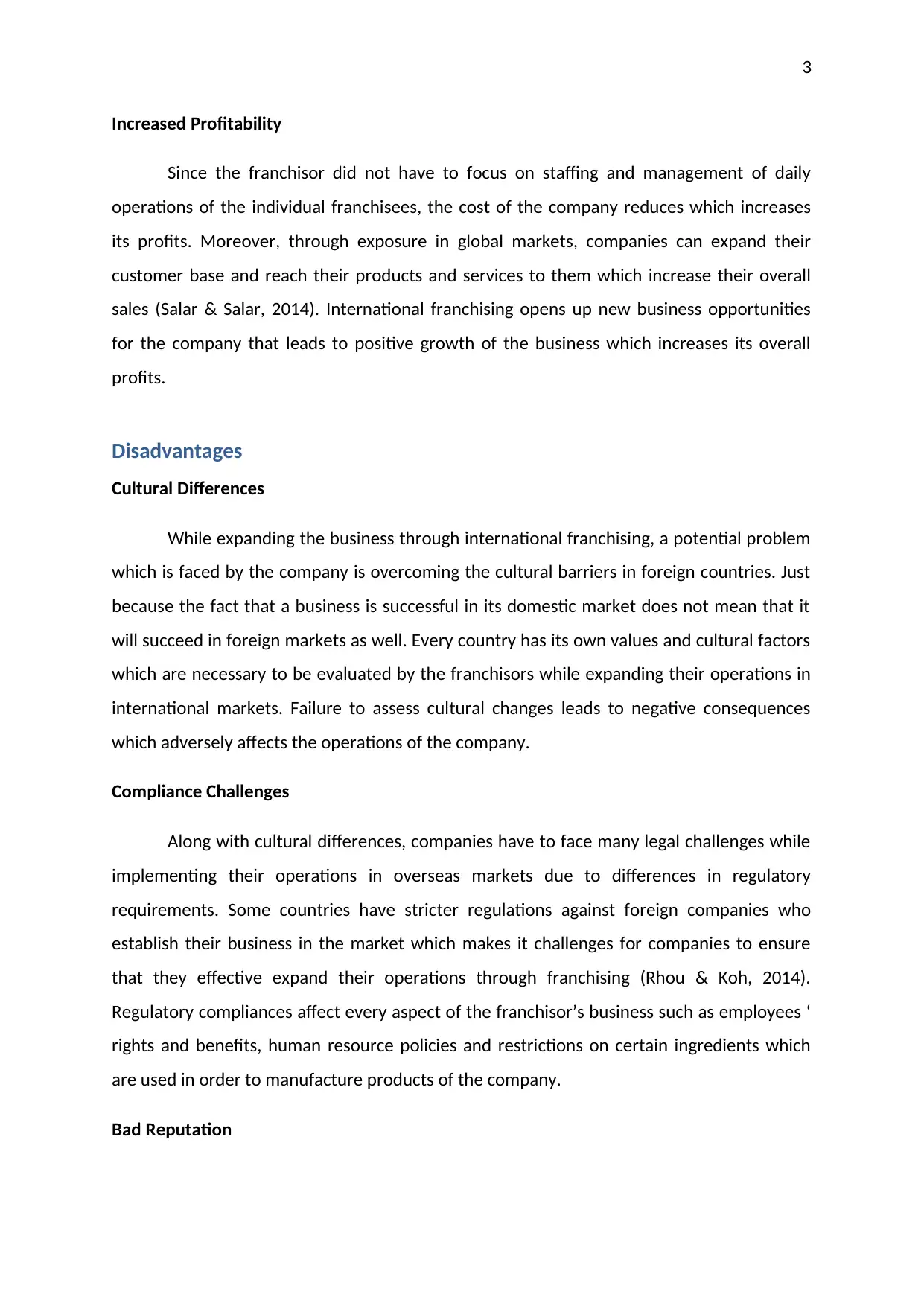
3
Increased Profitability
Since the franchisor did not have to focus on staffing and management of daily
operations of the individual franchisees, the cost of the company reduces which increases
its profits. Moreover, through exposure in global markets, companies can expand their
customer base and reach their products and services to them which increase their overall
sales (Salar & Salar, 2014). International franchising opens up new business opportunities
for the company that leads to positive growth of the business which increases its overall
profits.
Disadvantages
Cultural Differences
While expanding the business through international franchising, a potential problem
which is faced by the company is overcoming the cultural barriers in foreign countries. Just
because the fact that a business is successful in its domestic market does not mean that it
will succeed in foreign markets as well. Every country has its own values and cultural factors
which are necessary to be evaluated by the franchisors while expanding their operations in
international markets. Failure to assess cultural changes leads to negative consequences
which adversely affects the operations of the company.
Compliance Challenges
Along with cultural differences, companies have to face many legal challenges while
implementing their operations in overseas markets due to differences in regulatory
requirements. Some countries have stricter regulations against foreign companies who
establish their business in the market which makes it challenges for companies to ensure
that they effective expand their operations through franchising (Rhou & Koh, 2014).
Regulatory compliances affect every aspect of the franchisor’s business such as employees ‘
rights and benefits, human resource policies and restrictions on certain ingredients which
are used in order to manufacture products of the company.
Bad Reputation
Increased Profitability
Since the franchisor did not have to focus on staffing and management of daily
operations of the individual franchisees, the cost of the company reduces which increases
its profits. Moreover, through exposure in global markets, companies can expand their
customer base and reach their products and services to them which increase their overall
sales (Salar & Salar, 2014). International franchising opens up new business opportunities
for the company that leads to positive growth of the business which increases its overall
profits.
Disadvantages
Cultural Differences
While expanding the business through international franchising, a potential problem
which is faced by the company is overcoming the cultural barriers in foreign countries. Just
because the fact that a business is successful in its domestic market does not mean that it
will succeed in foreign markets as well. Every country has its own values and cultural factors
which are necessary to be evaluated by the franchisors while expanding their operations in
international markets. Failure to assess cultural changes leads to negative consequences
which adversely affects the operations of the company.
Compliance Challenges
Along with cultural differences, companies have to face many legal challenges while
implementing their operations in overseas markets due to differences in regulatory
requirements. Some countries have stricter regulations against foreign companies who
establish their business in the market which makes it challenges for companies to ensure
that they effective expand their operations through franchising (Rhou & Koh, 2014).
Regulatory compliances affect every aspect of the franchisor’s business such as employees ‘
rights and benefits, human resource policies and restrictions on certain ingredients which
are used in order to manufacture products of the company.
Bad Reputation
Paraphrase This Document
Need a fresh take? Get an instant paraphrase of this document with our AI Paraphraser
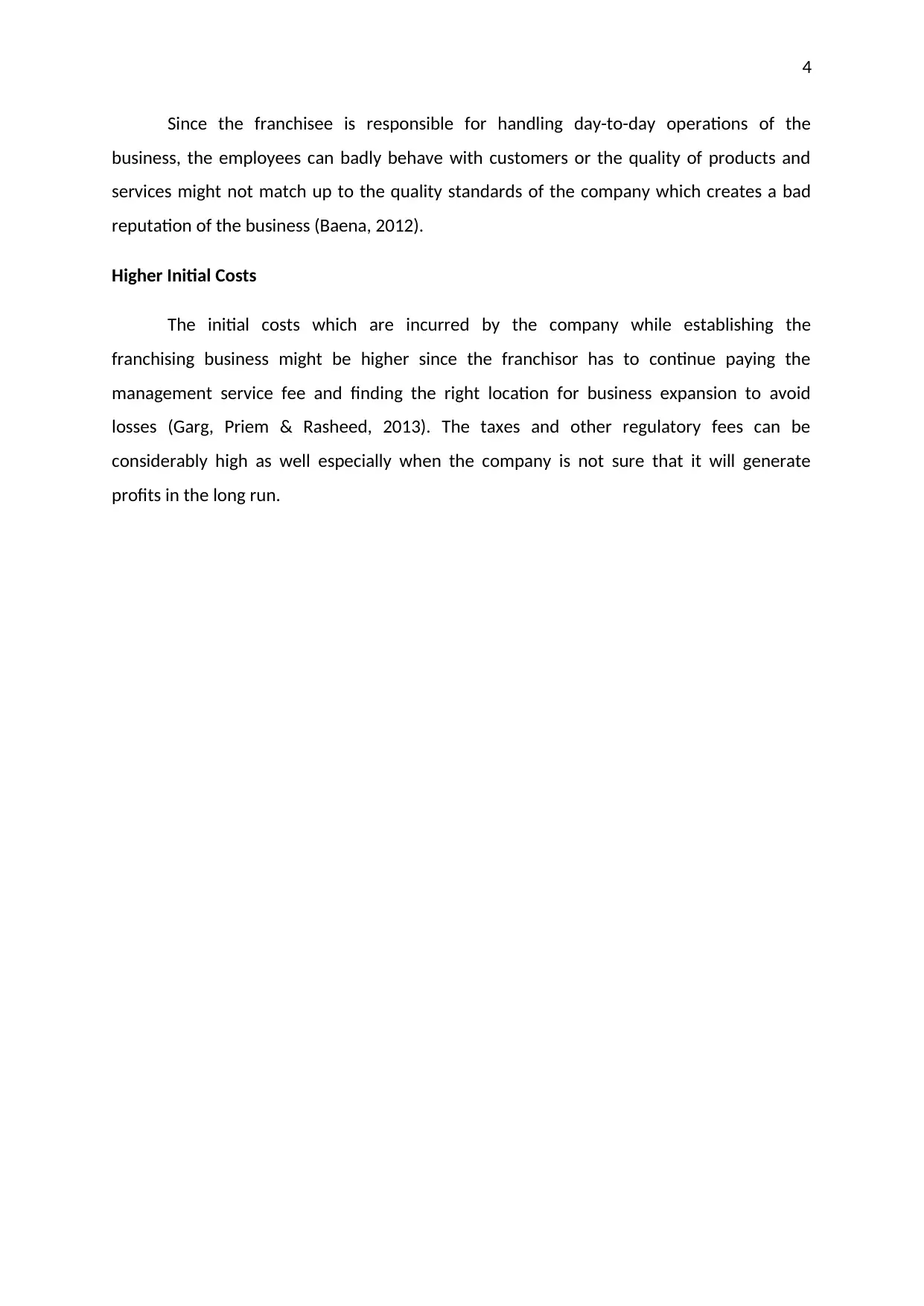
4
Since the franchisee is responsible for handling day-to-day operations of the
business, the employees can badly behave with customers or the quality of products and
services might not match up to the quality standards of the company which creates a bad
reputation of the business (Baena, 2012).
Higher Initial Costs
The initial costs which are incurred by the company while establishing the
franchising business might be higher since the franchisor has to continue paying the
management service fee and finding the right location for business expansion to avoid
losses (Garg, Priem & Rasheed, 2013). The taxes and other regulatory fees can be
considerably high as well especially when the company is not sure that it will generate
profits in the long run.
Since the franchisee is responsible for handling day-to-day operations of the
business, the employees can badly behave with customers or the quality of products and
services might not match up to the quality standards of the company which creates a bad
reputation of the business (Baena, 2012).
Higher Initial Costs
The initial costs which are incurred by the company while establishing the
franchising business might be higher since the franchisor has to continue paying the
management service fee and finding the right location for business expansion to avoid
losses (Garg, Priem & Rasheed, 2013). The taxes and other regulatory fees can be
considerably high as well especially when the company is not sure that it will generate
profits in the long run.
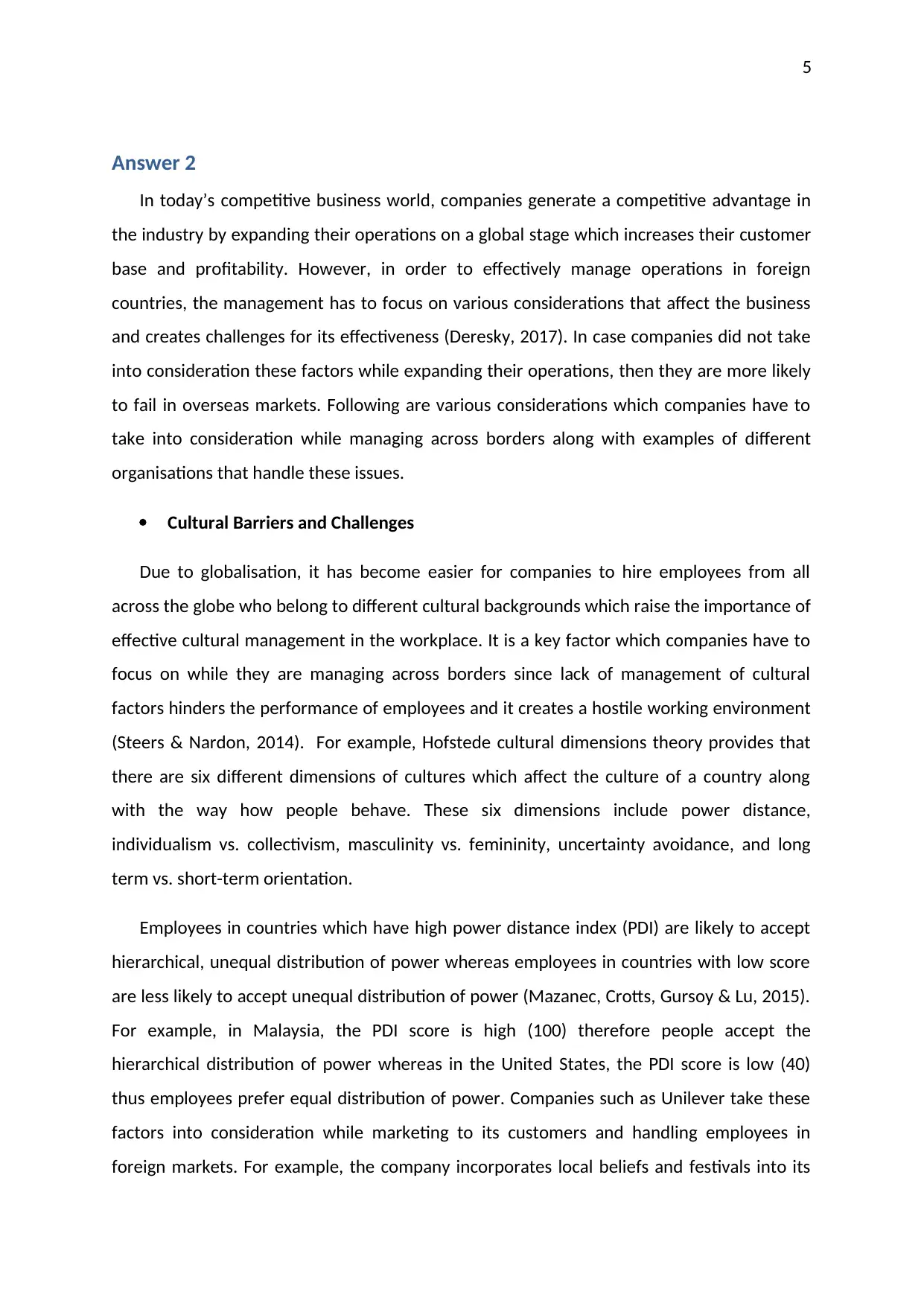
5
Answer 2
In today’s competitive business world, companies generate a competitive advantage in
the industry by expanding their operations on a global stage which increases their customer
base and profitability. However, in order to effectively manage operations in foreign
countries, the management has to focus on various considerations that affect the business
and creates challenges for its effectiveness (Deresky, 2017). In case companies did not take
into consideration these factors while expanding their operations, then they are more likely
to fail in overseas markets. Following are various considerations which companies have to
take into consideration while managing across borders along with examples of different
organisations that handle these issues.
Cultural Barriers and Challenges
Due to globalisation, it has become easier for companies to hire employees from all
across the globe who belong to different cultural backgrounds which raise the importance of
effective cultural management in the workplace. It is a key factor which companies have to
focus on while they are managing across borders since lack of management of cultural
factors hinders the performance of employees and it creates a hostile working environment
(Steers & Nardon, 2014). For example, Hofstede cultural dimensions theory provides that
there are six different dimensions of cultures which affect the culture of a country along
with the way how people behave. These six dimensions include power distance,
individualism vs. collectivism, masculinity vs. femininity, uncertainty avoidance, and long
term vs. short-term orientation.
Employees in countries which have high power distance index (PDI) are likely to accept
hierarchical, unequal distribution of power whereas employees in countries with low score
are less likely to accept unequal distribution of power (Mazanec, Crotts, Gursoy & Lu, 2015).
For example, in Malaysia, the PDI score is high (100) therefore people accept the
hierarchical distribution of power whereas in the United States, the PDI score is low (40)
thus employees prefer equal distribution of power. Companies such as Unilever take these
factors into consideration while marketing to its customers and handling employees in
foreign markets. For example, the company incorporates local beliefs and festivals into its
Answer 2
In today’s competitive business world, companies generate a competitive advantage in
the industry by expanding their operations on a global stage which increases their customer
base and profitability. However, in order to effectively manage operations in foreign
countries, the management has to focus on various considerations that affect the business
and creates challenges for its effectiveness (Deresky, 2017). In case companies did not take
into consideration these factors while expanding their operations, then they are more likely
to fail in overseas markets. Following are various considerations which companies have to
take into consideration while managing across borders along with examples of different
organisations that handle these issues.
Cultural Barriers and Challenges
Due to globalisation, it has become easier for companies to hire employees from all
across the globe who belong to different cultural backgrounds which raise the importance of
effective cultural management in the workplace. It is a key factor which companies have to
focus on while they are managing across borders since lack of management of cultural
factors hinders the performance of employees and it creates a hostile working environment
(Steers & Nardon, 2014). For example, Hofstede cultural dimensions theory provides that
there are six different dimensions of cultures which affect the culture of a country along
with the way how people behave. These six dimensions include power distance,
individualism vs. collectivism, masculinity vs. femininity, uncertainty avoidance, and long
term vs. short-term orientation.
Employees in countries which have high power distance index (PDI) are likely to accept
hierarchical, unequal distribution of power whereas employees in countries with low score
are less likely to accept unequal distribution of power (Mazanec, Crotts, Gursoy & Lu, 2015).
For example, in Malaysia, the PDI score is high (100) therefore people accept the
hierarchical distribution of power whereas in the United States, the PDI score is low (40)
thus employees prefer equal distribution of power. Companies such as Unilever take these
factors into consideration while marketing to its customers and handling employees in
foreign markets. For example, the company incorporates local beliefs and festivals into its
⊘ This is a preview!⊘
Do you want full access?
Subscribe today to unlock all pages.

Trusted by 1+ million students worldwide
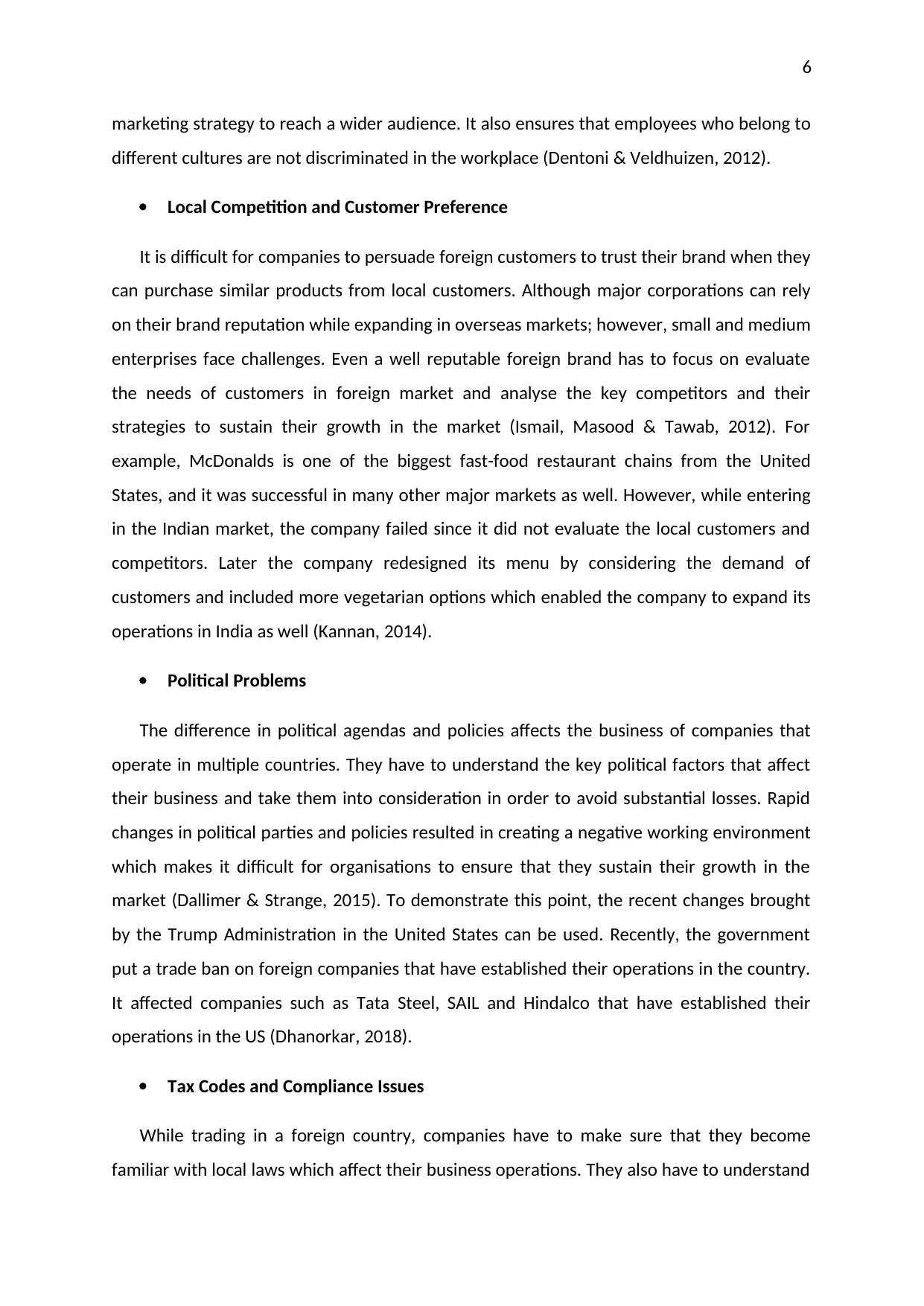
6
marketing strategy to reach a wider audience. It also ensures that employees who belong to
different cultures are not discriminated in the workplace (Dentoni & Veldhuizen, 2012).
Local Competition and Customer Preference
It is difficult for companies to persuade foreign customers to trust their brand when they
can purchase similar products from local customers. Although major corporations can rely
on their brand reputation while expanding in overseas markets; however, small and medium
enterprises face challenges. Even a well reputable foreign brand has to focus on evaluate
the needs of customers in foreign market and analyse the key competitors and their
strategies to sustain their growth in the market (Ismail, Masood & Tawab, 2012). For
example, McDonalds is one of the biggest fast-food restaurant chains from the United
States, and it was successful in many other major markets as well. However, while entering
in the Indian market, the company failed since it did not evaluate the local customers and
competitors. Later the company redesigned its menu by considering the demand of
customers and included more vegetarian options which enabled the company to expand its
operations in India as well (Kannan, 2014).
Political Problems
The difference in political agendas and policies affects the business of companies that
operate in multiple countries. They have to understand the key political factors that affect
their business and take them into consideration in order to avoid substantial losses. Rapid
changes in political parties and policies resulted in creating a negative working environment
which makes it difficult for organisations to ensure that they sustain their growth in the
market (Dallimer & Strange, 2015). To demonstrate this point, the recent changes brought
by the Trump Administration in the United States can be used. Recently, the government
put a trade ban on foreign companies that have established their operations in the country.
It affected companies such as Tata Steel, SAIL and Hindalco that have established their
operations in the US (Dhanorkar, 2018).
Tax Codes and Compliance Issues
While trading in a foreign country, companies have to make sure that they become
familiar with local laws which affect their business operations. They also have to understand
marketing strategy to reach a wider audience. It also ensures that employees who belong to
different cultures are not discriminated in the workplace (Dentoni & Veldhuizen, 2012).
Local Competition and Customer Preference
It is difficult for companies to persuade foreign customers to trust their brand when they
can purchase similar products from local customers. Although major corporations can rely
on their brand reputation while expanding in overseas markets; however, small and medium
enterprises face challenges. Even a well reputable foreign brand has to focus on evaluate
the needs of customers in foreign market and analyse the key competitors and their
strategies to sustain their growth in the market (Ismail, Masood & Tawab, 2012). For
example, McDonalds is one of the biggest fast-food restaurant chains from the United
States, and it was successful in many other major markets as well. However, while entering
in the Indian market, the company failed since it did not evaluate the local customers and
competitors. Later the company redesigned its menu by considering the demand of
customers and included more vegetarian options which enabled the company to expand its
operations in India as well (Kannan, 2014).
Political Problems
The difference in political agendas and policies affects the business of companies that
operate in multiple countries. They have to understand the key political factors that affect
their business and take them into consideration in order to avoid substantial losses. Rapid
changes in political parties and policies resulted in creating a negative working environment
which makes it difficult for organisations to ensure that they sustain their growth in the
market (Dallimer & Strange, 2015). To demonstrate this point, the recent changes brought
by the Trump Administration in the United States can be used. Recently, the government
put a trade ban on foreign companies that have established their operations in the country.
It affected companies such as Tata Steel, SAIL and Hindalco that have established their
operations in the US (Dhanorkar, 2018).
Tax Codes and Compliance Issues
While trading in a foreign country, companies have to make sure that they become
familiar with local laws which affect their business operations. They also have to understand
Paraphrase This Document
Need a fresh take? Get an instant paraphrase of this document with our AI Paraphraser
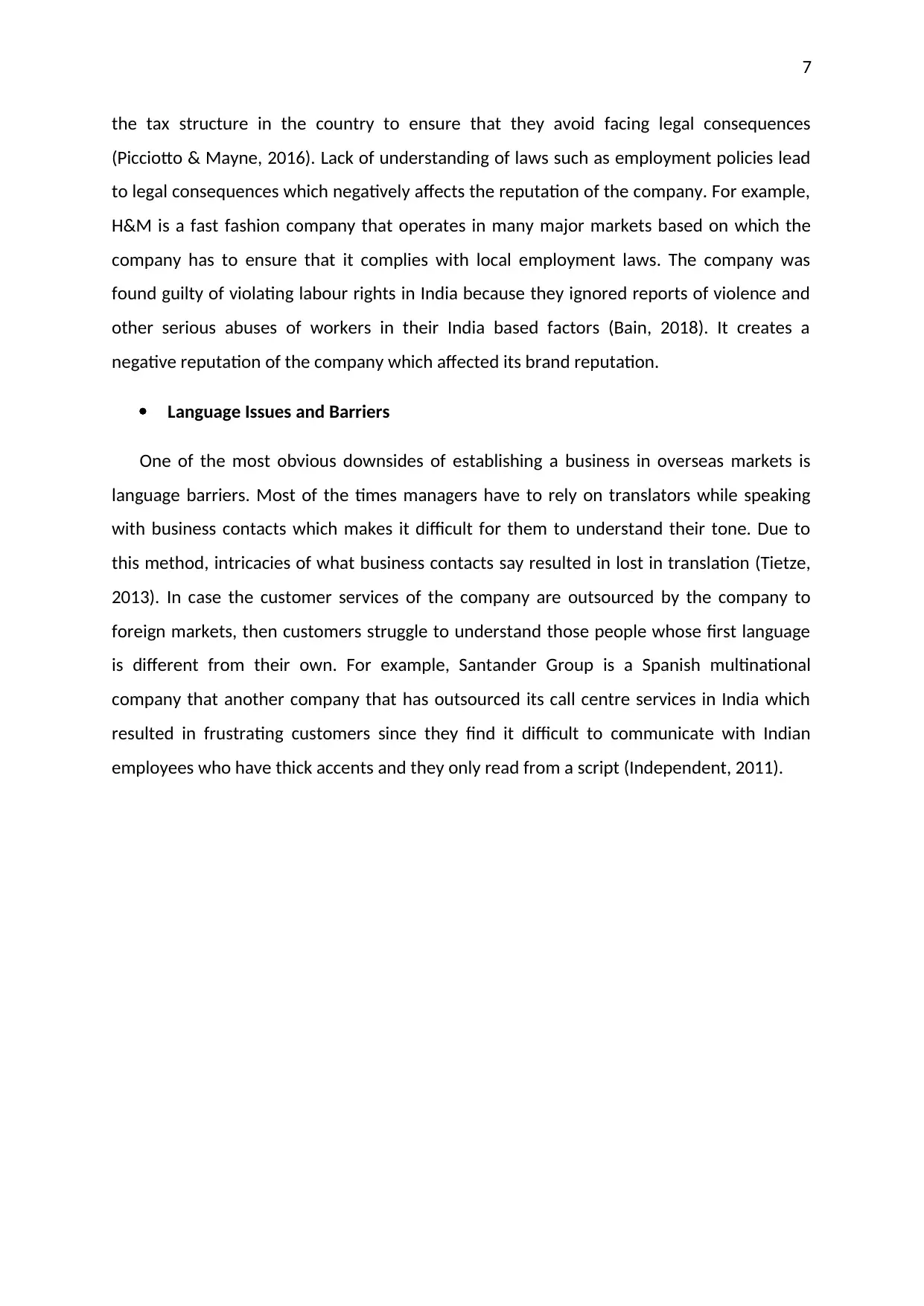
7
the tax structure in the country to ensure that they avoid facing legal consequences
(Picciotto & Mayne, 2016). Lack of understanding of laws such as employment policies lead
to legal consequences which negatively affects the reputation of the company. For example,
H&M is a fast fashion company that operates in many major markets based on which the
company has to ensure that it complies with local employment laws. The company was
found guilty of violating labour rights in India because they ignored reports of violence and
other serious abuses of workers in their India based factors (Bain, 2018). It creates a
negative reputation of the company which affected its brand reputation.
Language Issues and Barriers
One of the most obvious downsides of establishing a business in overseas markets is
language barriers. Most of the times managers have to rely on translators while speaking
with business contacts which makes it difficult for them to understand their tone. Due to
this method, intricacies of what business contacts say resulted in lost in translation (Tietze,
2013). In case the customer services of the company are outsourced by the company to
foreign markets, then customers struggle to understand those people whose first language
is different from their own. For example, Santander Group is a Spanish multinational
company that another company that has outsourced its call centre services in India which
resulted in frustrating customers since they find it difficult to communicate with Indian
employees who have thick accents and they only read from a script (Independent, 2011).
the tax structure in the country to ensure that they avoid facing legal consequences
(Picciotto & Mayne, 2016). Lack of understanding of laws such as employment policies lead
to legal consequences which negatively affects the reputation of the company. For example,
H&M is a fast fashion company that operates in many major markets based on which the
company has to ensure that it complies with local employment laws. The company was
found guilty of violating labour rights in India because they ignored reports of violence and
other serious abuses of workers in their India based factors (Bain, 2018). It creates a
negative reputation of the company which affected its brand reputation.
Language Issues and Barriers
One of the most obvious downsides of establishing a business in overseas markets is
language barriers. Most of the times managers have to rely on translators while speaking
with business contacts which makes it difficult for them to understand their tone. Due to
this method, intricacies of what business contacts say resulted in lost in translation (Tietze,
2013). In case the customer services of the company are outsourced by the company to
foreign markets, then customers struggle to understand those people whose first language
is different from their own. For example, Santander Group is a Spanish multinational
company that another company that has outsourced its call centre services in India which
resulted in frustrating customers since they find it difficult to communicate with Indian
employees who have thick accents and they only read from a script (Independent, 2011).
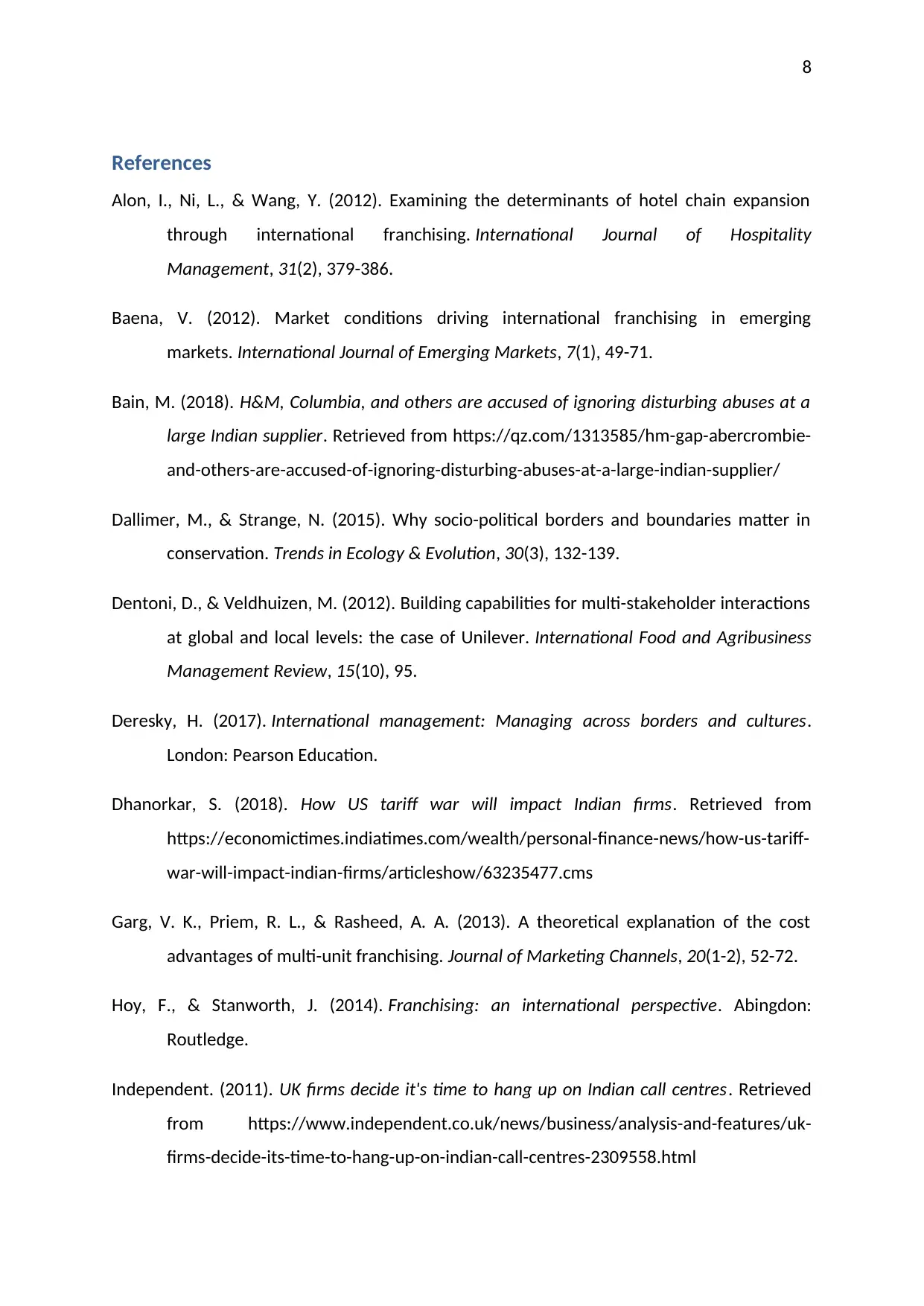
8
References
Alon, I., Ni, L., & Wang, Y. (2012). Examining the determinants of hotel chain expansion
through international franchising. International Journal of Hospitality
Management, 31(2), 379-386.
Baena, V. (2012). Market conditions driving international franchising in emerging
markets. International Journal of Emerging Markets, 7(1), 49-71.
Bain, M. (2018). H&M, Columbia, and others are accused of ignoring disturbing abuses at a
large Indian supplier. Retrieved from https://qz.com/1313585/hm-gap-abercrombie-
and-others-are-accused-of-ignoring-disturbing-abuses-at-a-large-indian-supplier/
Dallimer, M., & Strange, N. (2015). Why socio-political borders and boundaries matter in
conservation. Trends in Ecology & Evolution, 30(3), 132-139.
Dentoni, D., & Veldhuizen, M. (2012). Building capabilities for multi-stakeholder interactions
at global and local levels: the case of Unilever. International Food and Agribusiness
Management Review, 15(10), 95.
Deresky, H. (2017). International management: Managing across borders and cultures.
London: Pearson Education.
Dhanorkar, S. (2018). How US tariff war will impact Indian firms. Retrieved from
https://economictimes.indiatimes.com/wealth/personal-finance-news/how-us-tariff-
war-will-impact-indian-firms/articleshow/63235477.cms
Garg, V. K., Priem, R. L., & Rasheed, A. A. (2013). A theoretical explanation of the cost
advantages of multi-unit franchising. Journal of Marketing Channels, 20(1-2), 52-72.
Hoy, F., & Stanworth, J. (2014). Franchising: an international perspective. Abingdon:
Routledge.
Independent. (2011). UK firms decide it's time to hang up on Indian call centres. Retrieved
from https://www.independent.co.uk/news/business/analysis-and-features/uk-
firms-decide-its-time-to-hang-up-on-indian-call-centres-2309558.html
References
Alon, I., Ni, L., & Wang, Y. (2012). Examining the determinants of hotel chain expansion
through international franchising. International Journal of Hospitality
Management, 31(2), 379-386.
Baena, V. (2012). Market conditions driving international franchising in emerging
markets. International Journal of Emerging Markets, 7(1), 49-71.
Bain, M. (2018). H&M, Columbia, and others are accused of ignoring disturbing abuses at a
large Indian supplier. Retrieved from https://qz.com/1313585/hm-gap-abercrombie-
and-others-are-accused-of-ignoring-disturbing-abuses-at-a-large-indian-supplier/
Dallimer, M., & Strange, N. (2015). Why socio-political borders and boundaries matter in
conservation. Trends in Ecology & Evolution, 30(3), 132-139.
Dentoni, D., & Veldhuizen, M. (2012). Building capabilities for multi-stakeholder interactions
at global and local levels: the case of Unilever. International Food and Agribusiness
Management Review, 15(10), 95.
Deresky, H. (2017). International management: Managing across borders and cultures.
London: Pearson Education.
Dhanorkar, S. (2018). How US tariff war will impact Indian firms. Retrieved from
https://economictimes.indiatimes.com/wealth/personal-finance-news/how-us-tariff-
war-will-impact-indian-firms/articleshow/63235477.cms
Garg, V. K., Priem, R. L., & Rasheed, A. A. (2013). A theoretical explanation of the cost
advantages of multi-unit franchising. Journal of Marketing Channels, 20(1-2), 52-72.
Hoy, F., & Stanworth, J. (2014). Franchising: an international perspective. Abingdon:
Routledge.
Independent. (2011). UK firms decide it's time to hang up on Indian call centres. Retrieved
from https://www.independent.co.uk/news/business/analysis-and-features/uk-
firms-decide-its-time-to-hang-up-on-indian-call-centres-2309558.html
⊘ This is a preview!⊘
Do you want full access?
Subscribe today to unlock all pages.

Trusted by 1+ million students worldwide
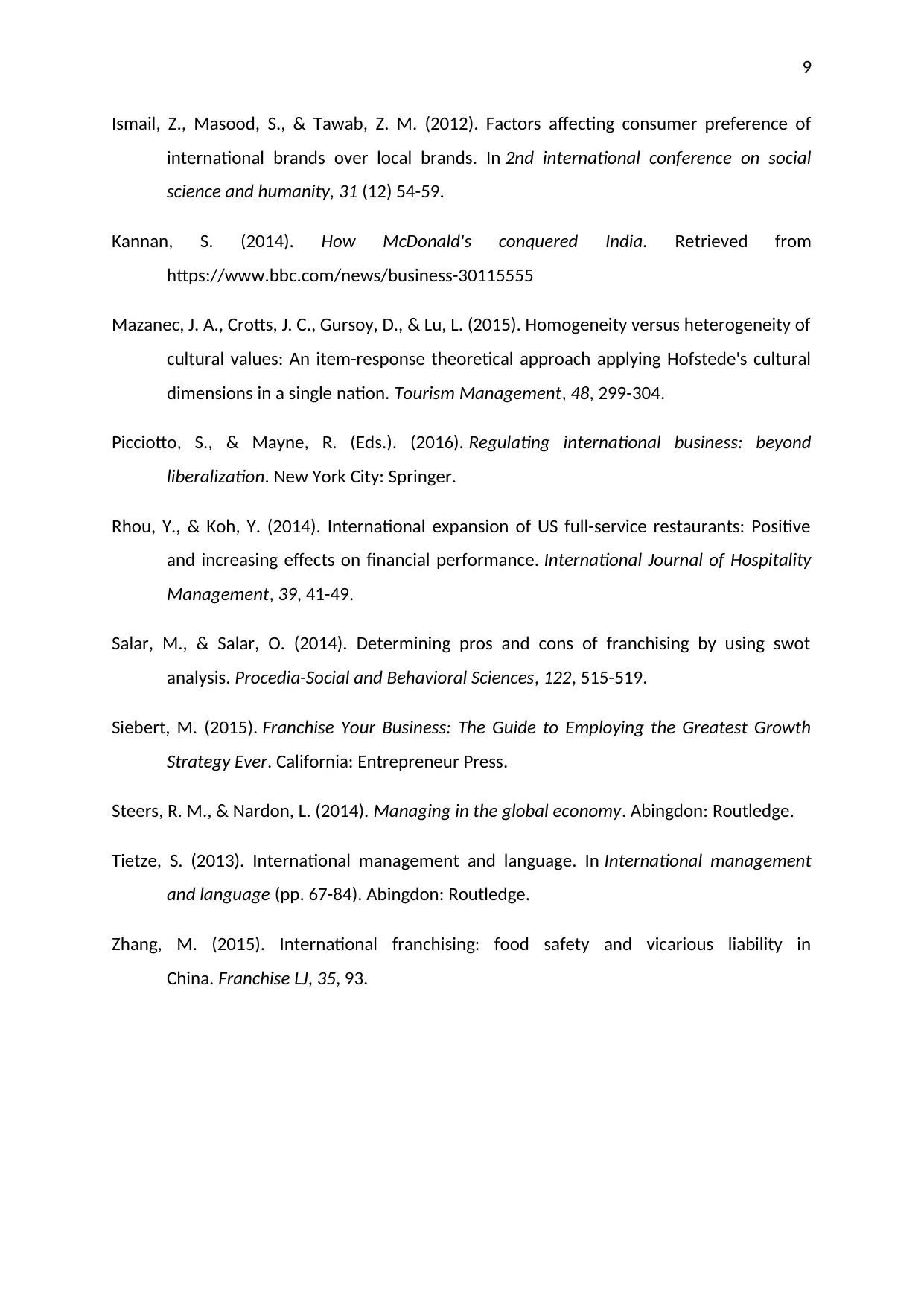
9
Ismail, Z., Masood, S., & Tawab, Z. M. (2012). Factors affecting consumer preference of
international brands over local brands. In 2nd international conference on social
science and humanity, 31 (12) 54-59.
Kannan, S. (2014). How McDonald's conquered India. Retrieved from
https://www.bbc.com/news/business-30115555
Mazanec, J. A., Crotts, J. C., Gursoy, D., & Lu, L. (2015). Homogeneity versus heterogeneity of
cultural values: An item-response theoretical approach applying Hofstede's cultural
dimensions in a single nation. Tourism Management, 48, 299-304.
Picciotto, S., & Mayne, R. (Eds.). (2016). Regulating international business: beyond
liberalization. New York City: Springer.
Rhou, Y., & Koh, Y. (2014). International expansion of US full-service restaurants: Positive
and increasing effects on financial performance. International Journal of Hospitality
Management, 39, 41-49.
Salar, M., & Salar, O. (2014). Determining pros and cons of franchising by using swot
analysis. Procedia-Social and Behavioral Sciences, 122, 515-519.
Siebert, M. (2015). Franchise Your Business: The Guide to Employing the Greatest Growth
Strategy Ever. California: Entrepreneur Press.
Steers, R. M., & Nardon, L. (2014). Managing in the global economy. Abingdon: Routledge.
Tietze, S. (2013). International management and language. In International management
and language (pp. 67-84). Abingdon: Routledge.
Zhang, M. (2015). International franchising: food safety and vicarious liability in
China. Franchise LJ, 35, 93.
Ismail, Z., Masood, S., & Tawab, Z. M. (2012). Factors affecting consumer preference of
international brands over local brands. In 2nd international conference on social
science and humanity, 31 (12) 54-59.
Kannan, S. (2014). How McDonald's conquered India. Retrieved from
https://www.bbc.com/news/business-30115555
Mazanec, J. A., Crotts, J. C., Gursoy, D., & Lu, L. (2015). Homogeneity versus heterogeneity of
cultural values: An item-response theoretical approach applying Hofstede's cultural
dimensions in a single nation. Tourism Management, 48, 299-304.
Picciotto, S., & Mayne, R. (Eds.). (2016). Regulating international business: beyond
liberalization. New York City: Springer.
Rhou, Y., & Koh, Y. (2014). International expansion of US full-service restaurants: Positive
and increasing effects on financial performance. International Journal of Hospitality
Management, 39, 41-49.
Salar, M., & Salar, O. (2014). Determining pros and cons of franchising by using swot
analysis. Procedia-Social and Behavioral Sciences, 122, 515-519.
Siebert, M. (2015). Franchise Your Business: The Guide to Employing the Greatest Growth
Strategy Ever. California: Entrepreneur Press.
Steers, R. M., & Nardon, L. (2014). Managing in the global economy. Abingdon: Routledge.
Tietze, S. (2013). International management and language. In International management
and language (pp. 67-84). Abingdon: Routledge.
Zhang, M. (2015). International franchising: food safety and vicarious liability in
China. Franchise LJ, 35, 93.
1 out of 10
Related Documents
Your All-in-One AI-Powered Toolkit for Academic Success.
+13062052269
info@desklib.com
Available 24*7 on WhatsApp / Email
![[object Object]](/_next/static/media/star-bottom.7253800d.svg)
Unlock your academic potential
Copyright © 2020–2025 A2Z Services. All Rights Reserved. Developed and managed by ZUCOL.





